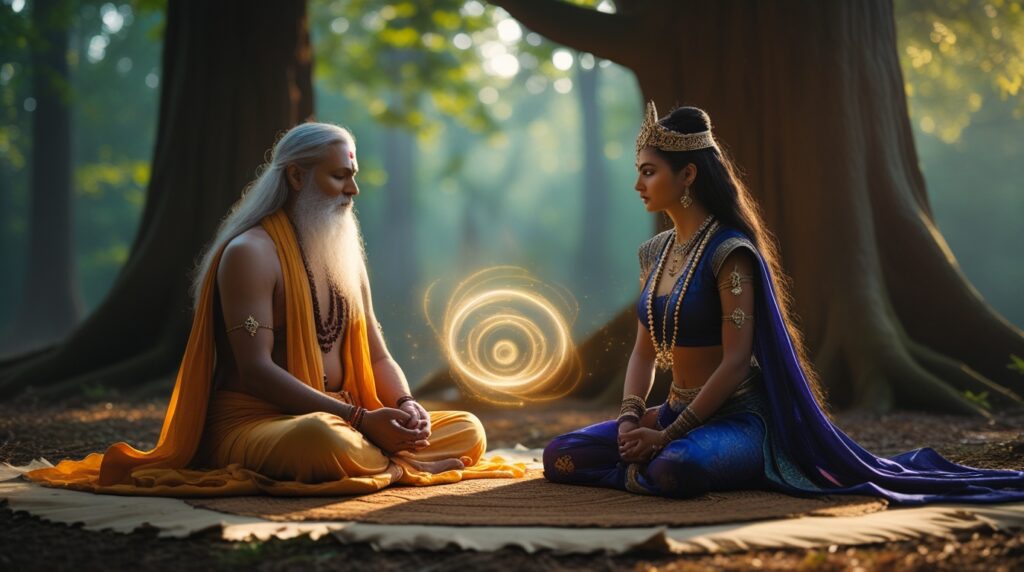Real story of Ravana’s birth reveals a powerful tale of divine curses, karmic destiny, and cosmic balance. Born to sage Vishrava and rakshasi Kaikesi, Ravana was no ordinary demon—his soul was once a celestial gatekeeper cursed to live as a mortal. Blending Brahmin wisdom with rakshasa traits, his origin reflects the duality of light and darkness, reminding us that even great intellect can fall to pride.
Ravana—the ten-headed demon king of Lanka—is often remembered as the archenemy of Lord Rama in the Ramayana. But behind the villainy lies a deeper truth—a story woven with divine curses, karmic consequences, and cosmic purpose.
Ravana wasn’t just a rakshasa (demon). He was a brilliant scholar, a master musician, a devout Shiva bhakta, and above all, a product of fate. His birth story reveals how even the most powerful beings are mere instruments in the divine play of dharma and karma.
The Unusual Union: A Sage and a Demoness

Ravana was born to Rishi Vishrava, a learned sage from the lineage of Pulastya Muni, one of Brahma’s mind-born sons. His mother, Kaikesi, was a rakshasi (demoness) and the daughter of Sumali, a powerful demon king.
Why Did This Marriage Happen?
Sumali wanted to revive the lost glory of the rakshasas. To achieve this, he believed that his daughter should marry a Brahmin of immense power and wisdom—thus, Kaikesi was sent to Rishi Vishrava.
Though the sage was reluctant, he agreed to marry Kaikesi after realizing her sincerity and the divine plan at play.
Rishi Vishrava warned her:
“Your children will be powerful, but inclined toward evil due to the timing of your request and your rakshasa lineage.”
This union produced four children: Ravana, Kumbhakarna, Vibhishana, and Shurpanakha.
The Soul of a Gatekeeper: Ravana’s Pre-Birth Identity
The true story of Ravana’s birth begins even earlier—in Vaikuntha, the heavenly abode of Lord Vishnu.
Ravana’s soul once belonged to Jaya, one of the two eternal gatekeepers of Vishnu. Along with Vijaya, he denied entry to the Sanat Kumaras—great sages and sons of Brahma. Enraged, they cursed Jaya and Vijaya to be born on earth as mortals and enemies of Vishnu.
The Curse and Its Cycles:
- 1st Birth: Hiranyaksha & Hiranyakashipu (slain by Varaha & Narasimha)
- 2nd Birth: Ravana & Kumbhakarna (slain by Rama)
- 3rd Birth: Shishupala & Dantavakra (slain by Krishna)
Thus, Ravana was not merely born—he was reborn as part of a divine arrangement to fulfill the cycle of karma and restore cosmic balance.
A Demon with Divine Traits
Though labeled a villain, Ravana was anything but ordinary. Born into a Brahmin household, he was a scholar of the Vedas, a master of music, a proficient astrologer, and an expert in Ayurveda and warfare.
Notable Facts About Ravana:
- Authored several works, including the Shiva Tandava Stotram.
- Created a musical instrument known as the Ravanahatha.
- Was a staunch devotee of Lord Shiva.
- Performed penance so intense that he offered his ten heads as sacrifice.
His immense power came from tapasya (austerity), not cruelty. But it was his ego, lust, and sense of invincibility that led to his downfall.
The Symbolism of Ravana’s Birth
Ravana’s story is rich in symbolic meaning:
- Ten heads represent knowledge of the six shastras and four Vedas.
- His Brahmin lineage shows that knowledge alone doesn’t guarantee virtue.
- His rakshasa nature reflects the dangers of unchecked ambition.
“Even the wisest can fall if they allow ego to rule over dharma.”
Why Ravana’s Birth Still Matters
In today’s world, Ravana serves as a timeless symbol of duality—a being who possessed great wisdom and yet fell from grace due to arrogance.
- He teaches us that intellect without humility is dangerous.
- His story reminds us that no one is above the laws of karma.
- His birth reflects how divine roles often come disguised in flawed human forms.
FAQs
-
Who were the real parents of Ravana?
Ravana was born to Sage Vishrava (a Brahmin) and Kaikesi (a Rakshasi), blending divine wisdom and demonic power.
-
Why did Ravana have ten heads?
His ten heads symbolize his mastery over the six shastras and four Vedas—or the ten qualities he tried to control but eventually succumbed to.
-
Was Ravana a Brahmin or Rakshasa?
By birth, he was half-Brahmin and half-Rakshasa. By karma and deeds, he aligned more with the Rakshasa nature.
-
Is Ravana a reincarnation of anyone?
Yes, Ravana is believed to be a reincarnation of Jaya, a cursed gatekeeper of Vishnu, destined to be born thrice as Vishnu’s enemy.
Conclusion: A Soul Torn Between Dharma and Desire
Ravana was not born evil. His birth was a complex result of cosmic strategy, karmic debt, and the eternal dance between good and evil. He remains one of Hindu mythology’s most fascinating figures—a genius, a devotee, a ruler, and ultimately, a tragic hero who could not overcome his inner demons.

